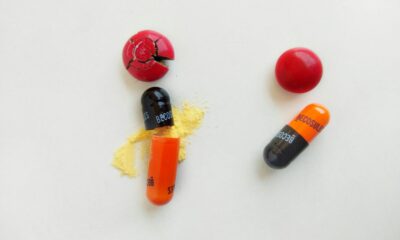Travel
Mount Etna volcanic eruption shuts down Catania international airport on Ferragosto public holiday
All flights have been cancelled or diverted to other airports in Sicily on Italy’s busy Ferragosto public holiday.
Travel to and from the Italian island of Sicily is currently disrupted due to a volcanic eruption that happened overnight.
Catania international airport remains closed on Thursday 15 August, with all arrivals and departures suspended after Mount Etna billowed smoke into the air. The volcanic ash affects visibility for pilots.
It is estimated that operations will resume at around 6pm but passengers have been advised to check their flight status before leaving home.
The disruption comes on one of the busiest days for travel as Italy celebrates its biggest national public holiday, Ferragosto.
Nearby towns have also been covered in black volcanic ash after the Voragine crater began erupting last night. A previous eruption happened two weeks ago on 4 August.
Catania is on the east coast of Sicily and at the foot of Mount Etna, Europe’s most active volcano.
Catania airport: What is the advice to passengers?
The airport’s management has advised passengers to check their flight status with their airline before leaving home.
You can check airline’s apps or websites for the most up to date information, as well as their social media channels. Also keep an eye on the email with which you made the booking as your airline or booking platform may contact you to advise you of changes.
Although no official numbers have been issued, the airport’s departure boards show cancellations for any flights due to land of take off before 6pm, and unspecified delays for those scheduled for 6pm or later.
There is currently only a handful of arrivals being diverted to other airports in Sicily – read on for more information.
Catania is Sicily’s most popular airport with international tourists, with the island at the height of the summer season.
Check your flight status here.
Are Catania flights being diverted and will transfers be provided?
Some arrivals and departures are being diverted to Comiso and Palermo airports.
Don’t forget that Sicily is the biggest island in the Mediterranean. It is twice the size of Cyprus, a country in its own right, and it takes around three hours to drive from Palermo in the northwest to Catania in the east.
Comiso airport is a one-to-two-hour drive from Catania airport; both are on the east of the island.
There are car hire companies at Sicily’s airports and there are also coaches between the main cities.
Currently, diversions to Palermo include selected Ryanair flights from Budapest, Brussels, Cagliari, Rome and London, while an Aeroitalia flight from Rome has been diverted to Comiso.
The status of some arrivals is yet to be updated by the carriers.
During previous travel disruption, airports or airlines have arranged free coaches to take passengers to the airport they were due to land at or depart from. You may only be able to find information on these free transfers once you arrive at the airport.
Will passengers be able to claim compensation?
Airlines are required to offer you another flight or a refund is a flight is cancelled or delayed by more than three hours.
However, this is only when they could have prevented the disruption. In the case of a volcanic eruption, it is not their fault.
However in most cases airlines will still endeavour to get passengers to their final destination.
It’s always wise to have travel insurance as you may be able to claim back for unexpected expenses.
Is it safe to travel to Sicily?
Yes, it is still safe to travel to Sicily, even when Mount Etna is erupting.
There is an ongoing drought in Sicilybut the majority of hotels and other tourist accommodation are open and operating as normal.
Travellers should take the usual precautions for hot weather – drink plenty of water, stay in the shade during the hottest hours of the day and seek medical attention if you feel unwell.
Where is Mount Etna and is it dangerous?
Mount Etna is on the east coast of the Italian island of Sicily.
It is Europe’s most active volcanoes and has been going through an especially active period for the last five years.
Although Mt Etna erupts frequently, lava has not reached nearby towns since the 1800s.
Etna more than 200 craters and when one of these does erupt, black volcanic ash lands in the city of Catania, as its foot, and the many surrounding towns and villages. This is inconvenient to residents but usually not a problem for visitors.
Even during an eruption, there are many hiking trails and paths that are still safe, though it is a legal requirement to go up with a qualified local mountain guide.
Travel
Hempcrete: The green brick taking on the challenge of climate change
Hempcrete is a bio-based building material helping to power the drive to net-zero, but how can a product developed a millennia ago help tackle today’s environmental challenges? Euronews Culture gets down and dirty with a material that has Europe’s eco-conscious architects high with excitement.
It really doesn’t look like much, but hempcrete is the green building material that’s got eco-savvy homeowners and architects excited by its potential to be a sustainable alternative to environmentally expensive bricks and concrete.
It is made using a carefully calibrated mixture of hemp shiv – the dried inner core of the hemp plant – mixed with lime and water.
But although hempcrete seems like a very modern building material, it has a history stretching back over 1,500 years.
Hemp plaster from the sixth century still lines the walls of the UNESCO-designated Ellora Caves in India, and hemp mortar has been discovered in ancient Merovingian bridge abutments in France – which is fitting, as France was at the forefront of the 1980s drive to modernise hempcrete and introduce it to a new generation.
Back then, wet hempcrete was cast onsite, as concrete is today, but the challenge of getting the mixture right made it a tricky product for laypeople to use. Too much of any of the three ingredients could make the material runny and weak, while not enough could cause crumbling.
Its drying time also posed problems. In fair conditions, cast hempcrete can take between four and six weeks to cure. But a cold damp winter could slow the process to at least six months, restricting its mass use across northern Europe.
Impeccable environmental credentials
Despite the challenges, hempcrete’s undeniable environmental credentials have meant it was a case of when, rather than if, it would muscle its way into the mainstream building trade.
Liam Donohoe, chief operating officer at UK Hempcrete – a Derbyshire-based company designing and supplying materials to building projects using hempcrete – tells Euronews Culture that sustainability plays a part in every area of the product’s development.
“Hemp, unlike conventional crops, doesn’t require a lot of fertilisers or pesticides to protect it as it grows. The type of fibrous hemp usually used in construction is a tall plant that grows quickly and so can be cropped and planted quite close together, naturally suppressing weeds,” he says.
“I’m not saying it takes no energy to produce hempcrete, it does. But when you compare it to man-made insulation and wall infills, it has an unlimited life span and the primary ingredient is a renewable crop that costs a lot less energy and carbon to produce.”
Research and development changed everything
Experiments in France and at Belgium’s University of Leuven in the early 2000s saw researchers begin tackling the barriers preventing hempcrete from realising its full potential as a mainstream building product.
The eureka moment was the development of the hempcrete block or ‘green brick’, which took the specialist skill and guesswork out of using the material.
The lightweight fibrous block opened up a new world of possibilities for the material without diminishing any of its eco-credentials. It is free from volatile organic compounds (VOC) and indefinitely retains its acoustic, moisture absorption and thermal conductivity properties – in sharp contrast to synthetic insulation that decompresses over time to become less effective.
It is now a consistent, lightweight and reliable product that can be easily transported to sites and used by jobbing builders without extensive training.
Hempcrete versus concrete
Despite its versatility, experts are quick to dismiss comparisons between hempcrete and concrete. Concrete is a reinforced, structural building material that can support its own weight, while hempcrete is used around a frame of wood, steel or concrete. Think of it as insulation that doesn’t cost the Earth.
“When hempcrete is made into blocks, it’s strong enough to support itself, so can be used to build multi-storey buildings. There are a number of examples in the Netherlands, South Africa and France, so it’s not that you can’t build high or strong structures with it, but you need to use it around a frame,” Donohoe says.
“Researchers are working on developing a structural application for hempcrete, but that currently means usually tweaking the recipe. The sweet spot is finding something that’s very consistent, that goes onto the building site just like any other building product, without compromising too much on the carbon inputs to the recipe by using ingredients that are less sustainably produced.”
Hempcrete’s time has come
Hempcrete is proving itself to be well-suited to the radically different way many lives are lived in the post-Covid world and the desire to do more to ensure the survival of the planet.
“In the recent past people would commute to their heated offices, do a day’s work and return home to put the heating on for an hour or two in the evening,” Donohoe says.
“We don’t live like that now. Increasingly a lot of us want a nice stable healthy environment at home, because that’s where many live and work.
“Synthetic insulations, such as polyurethane and fibreglass, form a barrier between heat and cold, but they heat-up and cool down very quickly. By contrast, natural materials, such as earth, or hempcrete, are a little slower initially to heat up, but they retain their heat a lot longer – a process called ‘decrement delay’. This process suits today’s world, where people are at home a lot longer, and the heating is on more frequently during the colder months,” he adds.
Europe is setting the pace in hempcrete use
The major players in the hempcrete world hail from Europe. In the Netherlands, France, Belgium, Germany and Italy, hempcrete is routinely used to retrofit old buildings and form the core of new builds.
One of the biggest producers is Belgian companyIsohemp. The Fernelmont-based business has been trading since 2011 and operates in five countries.
It produces more than a million hempcrete blocks a year and claims that the projects it has worked on have saved 18,000 tonnes of C02 from the environment – that’s equivalent to the emissions produced by a patrol car circumnavigating the planet 32,000 times.
Although the UK is a few steps behind the pack, the gap is closing fast. UK Hempcrete knows of 300 to 400 houses in the UK that have been built with hempcrete and sees a bright future for the product.
“The future of hempcrete will be in prefabrication using modular methods of construction. We already have timber-framed houses largely assembled in factories, brought to the site and constructed there. There’s no reason why hempcrete houses can’t be similarly prefabricated,” Donohue says.
“In Britain, companies are building conventional family homes with hempcrete that look just like estate homes anywhere in the country, but with vastly superior eco-performance benefits.
“A focus for us is retrofitting pre-1940s housing stock. We are working with community housing cooperatives around the country who have old houses that are cold and leaky. The biggest opportunity is developing that market alongside the growing newbuild market.”
But perhaps the full potential of hemp and hempcrete has yet to be realised. BMW currently use a weight-saving hemp polymer in the door panels of its i3 electric car, while in southern Italian earthquake zones hempcrete is used as a flexible building material that can cope with Earth movement, rather than rigid, brittle concrete.
The future of hempcrete as a green building material looks assured. But with researchers working on ever more innovative ways to use it, perhaps we’ve only seen a tantalising glimpse of the difference it can make.
Travel
Venice 2024 review: ‘The Order’ – Jude Law vs white supremacists
Australian director Justin Kurzel adapts real-life events and delivers a gripping thriller about a notorious hate group in the US, as well as deliver a cautionary tale about the current heirs of white supremacists.
Based on the non-fiction book “The Silent Brotherhood” by Kevin Flynn and Gary Gerhardt, Justin Kurzel’s The Order is named after the white supremacist terrorist organisation which murdered three people and committed numerous robberies in an effort to provoke a race war.
The group took inspiration from the racist book “The Turner Diaries”, which is central to Kurzel’s film. Labelled the “bible of the racist right” by the FBI, it charts the steps necessary to start a revolution in the US which ultimately leads to the overthrowing of the federal government and a race war culminating in the extermination of non-whites and Jews. “The Day of the Rope,” neo-Nazi author William Luther Pierce calls it.
If all of this rings a troubling bell with regards to “Jews will not replace us” chants led by white supremacists in Charlottesville, the 2021 Capitol insurrection, and the gallows set up for ex-Vice President Mike Pence, it’s by design. “The Turner Diaries” has inspired numerous acts of violence and remains bedside reading for many active hate groups and domestic terrorists.
This resonance with present-day extremism and the divided political landscape in the US is at the core of The Order, even if it winds the clock back to 1983.
We meet FBI agent Terry Husk (a moustachioed and constantly gum-chewing Jude Law), who arrives in Coeur d’Alene, Northwest Idaho, where he immediately spots several posters and leaflets belonging to the Aryan Nation. His eyes are trained, as the grizzled veteran has gained a reputation for investigating the KKK and similar racist factions. He soon finds out, which the help of local police officer Jamie Bowen (Tye Sheridan), that a steadily expanding hate group is preparing something big, prefaced by a series of bank robberies, armoured car heists, and bomb attacks.
While hate groups don’t usually rob banks, The Order’s leader Bob Mathews (Nicholas Hoult) is well on his way to building a militia, having grown tired of the “all words no action” stance of hate preacher Reverend Richard Butler and his Church of Jesus Christ Christian.
“We are now in a full state of war,” Mathews tells his flock. And he means to see it through, even if that means sacrificing himself and not seeing his precious bloodline thrive: “One thing that never dies is the fame of a dead man’s deeds.”
Following hard-hitting movies like Snowtown, True History of the Kelly Gang and Nitram, Australian filmmaker Kurzel continues to impress when it comes to depicting violence in a realistic and bracing way. From bank jobs and resonating gun shots to the murder of Jewish talk-radio host Alan Berg (Marc Maron), the violence feels choreographed without seeming affected.
In this respect, and thanks to the stellar work of editor Nick Fenton, it’s no stretch to compared some of the robberies, gun battles and the cat-and-mouse game between Husk and Mathews to Michael Mann’s Heat, and even David Mackenzie’s underappreciated crime western Hell or High Water. The Order may not rise to their levels or impress in quite the way as these films, but it remains a gripping thriller throughout.
The story and its beats can be predictable at times – the dour old hand teaming up with the eager rookie with everything to lose – but the performances see The Order through. Jude Law and Nicolas Hoult are convincing in both their roles, with the latter stealing the show as the subtly charismatic embodiment of everyday evil. It’s through the strength of Hoult’s performance that the film becomes an eerie cautionary tale of current events.
The Order may have been taken down and some of its members still behind bars, but Christian nationalism and the extreme branches of the MAGA crowd show that no matter what forms their beliefs take, the real-life cult’s decedents are alive. And, most hauntingly of all, thriving.
The Order premieredat the 81st Venice Film Festival in Competition.
Travel
Venice 2024 review: ‘Babygirl’ – Nicole Kidman shines in sex-positive BDSM drama
Already the most talked about film in this year’s Competition, Nicole Kidman stars as a woman willing to risk it all for a torrid affair that allows her deepest desires to finally surface.
Romy (Nicole Kidman) has got it all. She is a successful and admired CEO with a doting husband Jacob (Antonio Banderas) and two teenage daughters (Esther McGregor and Vaughan Reilly).
That said, the fact that she heads up a company specialized in robotics and that her husband is a theatre director should tell you that she knows a thing or two about living life in automation mode and excels when it comes to nailing a performance when she needs to. As we learn in the first scenes of Babygirl, she is sexually going through the motions and needs to head to her laptop for some sub-dom roleplay once she’s had a seemingly intense orgasm with her husband.
She begins an affair with the cocksure Samuel (Harris Dickinson), one of her new interns who she previously clocked in the street taming a dog who was about to launch itself at her. She’s immediately drawn to his assertiveness, his disregard for office niceties and his general disobedient attitude. As their BDSM-tinged relationship develops, so do the threat levels.
Is Romy finally getting to explore the sexual terrains she has previously denied herself, putting her on the way to sexual fulfilment? Or is she being used by a rather predatory man who could torpedo her everything she has built at the drop of hat?
As Samuel casually points out: “I could make one call and you could lose everything.”
But that could be the biggest turn on of all… And she seems to realize it. When Jacob asks her early on if he is relevant to her as a director, she replies: “We are all irrelevant – we need to pay more attention to the avalanche that’s going to cover us very soon.”
Prescient words, as an avalanche is coming.
To label Babygirl a transgressive erotic drama might be doing it something of a disservice; while it is steamy at times, it’s more of a late-stage coming-of-age tale that deals with self-discovery and focuses on a woman’s vulnerability, shame, rage, and how she deals with slanted power dynamics.
Dutch director Halina Reijn, who previously directed Bodies Bodies Bodies, as well as Instinct, which centred on a psychosexual relationship between a sex offender and his therapist, shows once again that she can delve into illicit desires and gendered power dynamics with brio. Here, she shines not only in the way she explores how “shameful” desires need their space – and how their suppression can be just as potentially dangerous as a torrid affair – but also in her lack of moral judgement. Reijn’s film embraces the often-contradictory forces that make people who they are, and never judges its characters.
There are no good or bad binaries here; just complex people with voracious desires which adds to the central question: Who is in control?
Kidman excels when it comes to embodying this, and is mesmerizing throughout. She imbues Romy with an understated vulnerability and conveys her inner conflicts despite attempting to keep up appearances. As for Banderas, he delivers an understated performance that completely matches hers with significantly less screen time.
What prevents Babygirl from being a true knockout, however, are superior cinematic touchstones, as it’s hard (pipe down at the back) not to think of The Piano Teacher, Elle or Eyes Wide Shut. All feel relevant since (in order): Isabelle Huppert is this year’s jury president and starred in Michael Haneke’s erotic psychological drama; she also starred in the 2016 psycho-sexual thriller by Paul Verhoeven, a director who Reijn acted for in Black Book in 2006; and Kidman was on the Lido 25 years ago with the late director’s final – and controversial – film. Granted, all directed by men but feature complex female characters and explore layered feminine desire in ways that make behind-the-camera genders irrelevant.
Reijn’s take on the 80s erotic thriller remains a bold update, and never limits itself to post #MeToo moralising. It’s a brave film considering its candour and casting, as the film does hit at the heart of American puritanism and puts certain films that consider themselves to be envelope-pushing in perspective, highlighting once more that some of its supposedly taboo-shaking predecessors (9 ½ Weeks, Fifty Shades of Grey) are in fact tame in the extreme – and in the latter’s case, deeply insulting. However, the aforementioned films from Haneke, Verhoeven and Kubrick felt more challenging when exploring complicated and prudishly impermissible yearnings.
While Babygirl is an admirably sex-positive drama, it does tend to limit itself to: Honest and open communication regarding desire is vital. Crucial though that message is, the film may not be the electrifying, nor thought-provoking, jolt one could have hoped for.
Babygirl premiered at the 81st Venice Film Festival in Competition.
-

 Sports7 days ago
Sports7 days agoOfficial: Juventus announces sixth purchase
-

 Health & Society7 days ago
Health & Society7 days agoThe intoxicated society
-

 Politics5 days ago
Politics5 days agoThe Russian patriarch to Putin: You are the first truly Orthodox president
-

 Sports6 days ago
Sports6 days agoBeautiful Juve: Vlahovic and youth rout Verona. Thiago Motta first
-

 Sports6 days ago
Sports6 days agoJuventus, Vlahovic: “Now we play a different game.”
-

 Politics4 days ago
Politics4 days agoEU Intensifies Pressure: Six-Month Extension of Russia Sanctions
-

 Health & Society3 days ago
Health & Society3 days ago7 Superfoods That Will Boost Your Fitness Results
-

 EU & the World5 days ago
EU & the World5 days agoBrittany Cartwright Files for Divorce From Jax Taylor After 5 Years of Marriage









